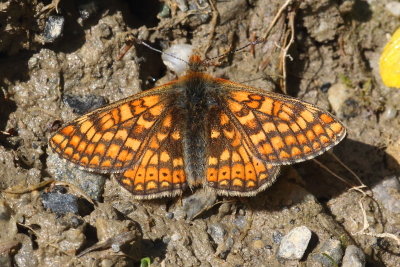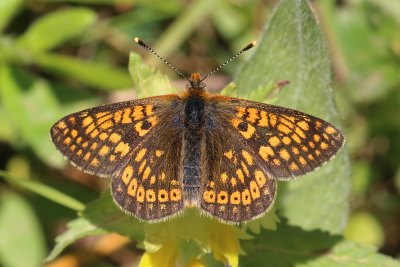



















34512_female_Var_21Apr14











Marsh Fritillary (Euphydryas aurinia)
2024 photographs highlighted in yellow. Click on any photograph to go to an enlarged picture, or simply scroll down the page.
|
A beautifully marked butterfly, with a delicate orange upf submarginal band with smudgy beige centres. It is rare and has a restricted distribution in the UK, but is reasonably widespread in France with a wide altitude range, often (and maybe most commonly) found at altitude. In the UK it is normally associated with damp areas, but my experience in France is that it is found in hot dry lowland areas, where it emerges in April, or at high or very high altitudes where the flight period is later, according to altitude.
The forewing colouration can vary from almost constant pale orange to a more variegated pattern of alternating lighter and darker bands.
There are three subspecies that occur in the PACA (Provence, Alpes, Côte d'Azur) region: provincialis, which occurs in low-lying areas and low-level hills (and includes all the specimens from Var on this page); frigescens, which occurs in higher levels of hilly areas and sub-Alpine regions; and the small dark subspecies glaciegenita that occurs above 2000m altitude. |
Several of the above individuals fit that latter description to a greater or lesser degree, with 52452 being the most extreme example. It is hard to believe that 52452 and 15734 are the same species.
In May 2022 I made a first-ever trip to the eastern Pyrénées at that time of year and encountered large numbers of aurinia of the form beckeri. This is a particularly appealing form of aurinia, a species which has a number of appealing forms, hence the large number of images on this page. It was flying in company with the very localised (in France, at least) Spanish Fritillary (E. desfontainii) which it greatly resembles in flight.
A superb video of the life-cycle of aurinia has been produced by Filming VarWild and can be viewed on YouTube here: www.youtube.com/watch?v=F_-mZUxkOxQ |
| ref | sex |
observations |
alt. m |
| 20009 | M |
the markings and colouring of 20009 are, in my opinion, just sensational. It is breathtakingly beautiful. |
220 |
| 20532 | M |
a rather dull, small aurinia from the semi-mountainous wetlands of the département of Doubs in the north-east of France. |
860 |
| 10420 | M |
a typical male, great contrast in the upperside markings, with the whitish uph marginal marks setting the contrast nicely. The rather odd pose of one forewing held down seems to occur with some regularity. Aurinia sometimes settles with both wings folded back in a rather moth-like pose. |
1000 |
| 12284 | M |
a darker male seen at high altitude of 2000m. It was not the smaller, mountain subspecies debilis, which looks like a rather smaller and duller version of the nominate form, and occurs in the same region. It does, however, look like an intermediary form between aurinia and debilis. |
2050 |
| 46142 | M | a particularly dark male from medium-high altitude near Mont Lozère. | 1540 |
| 15734 | M |
a particularly small and dark male from the Jura. |
860 |
| 29086 | M | a fairly typical male of this region. | 185 |
| 33518 | M | another example of the variability of this species, being broadly halfway between the orange and dark forms, perhaps surprising that it is not darker given the altitude. | 2010 |
| 45510 | M | another example of the variability of high altitude aurinia, this one being from the département of Savoie which is to the north of Hautes-Alpes. 45510 is rather paler than the other high altitude specimens, although this does not appear to be a result of wear. | 1930 |
| 48005 | M | a male, from Lincolnshire where aurinia had been successfully introduced. It was a little different to other males flying there as it had limited contrast across the markings. 48008 and 48017 were from the same site. Thanks to Pete Smith (https://www.butterflydreams.co.uk/) for showing us the site. | 20 |
| 48008 | M | a male, also from Lincolnshire, but rather more marked in the way I would expected for a UK aurinia. | 20 |
| 50746 | M | a male of the form beckeri, very orange and lightly marked. | 620 |
| 50766 | M | a male of the form beckeri, also quite orange but with stronger black edging to the marks. | 620 |
| 52425 | M | a fairly normal-looking male from high altitude. It was flying in company with 52452 which looks very different indeed. | 2050 |
| 52452 | M | a very dark and dusky male from high altitude. It was flying in company with 52425, which illustrates the extreme variability of this species. | 2050 |
| 48017 | F | a female, also from Lincolnshire, marked similar to 48008, but fresh and very appealingly marked. Contrast 48017 with the French 40163 below. | 20 |
| 10465 | F |
a female, from the same location as 10420. It is rather larger than the male, with slightly less contrast in the markings. |
1000 |
| 34512 | F | a female, not unlike 20009 except that the uph marginal lunules are quite pale. | 220 |
| 40163 | F | a particularly lightly-marked freshly-emerged female. | 370 |
| 41624 | F | a high altitude female, yet another variant in the markings of this exceptionally variable species. Curiously, having seen many high altitude forms of this species, not one has been clearly debilis. | 2290 |
| 17314 | F? | I suspect this may be a female from the body length, although this is not at all clear. It is quite dark and lacking the colourfulness of its lowland cousins, although not as dark as some on this page from considerably lower altitudes. | 1700 |
| 49111 | F? | a suspect this is a female from what can be seen of the body shape and length. It is of the form beckeri and rather orange-red compared to the norm, although it was a hot day and they rarely settled with open wings. | 620 |
| 50692 | M | a male of the form beckeri, fairly normal in terms of colouration. | 620 |
| 50724 | M | a male of the form beckeri, a rather deep red-orange ground colour and very white marginal lunules. | 620 |
| 49153 | M | a male from its territorial pose and its body length. It is of the form beckeri and very red, contrasting very nicely with the beige marks, making for a very appealing underside. | 620 |
| 49127 | M | a male from its territorial pose and its body length. It is of the form beckeri. | 620 |
| 49149 | F | clearly a female from what can be seen of the body shape. It is of the form beckeri and very red with a strong sequence of post-discal spots. One of the most appealing undersides of any species. | 620 |
| 33397 | M | a male underside, rather lightly marked. | 1800 |
| 34548 | M | a male. | 220 |
| 10473 | F |
a female, a rare opportunity for an underside shot. |
1000 |
| 40114 | PUPA | a chrysalis, one of many at this location where aurinia emerges in huge numbers in May. | 220 |
10420_male_Alpes-Maritimes_9May08
12284_male_Hautes-Alpes_8Jul08
33518_male_Hautes-Alpes_8Jul13
48005_male_UK, Lincolnshire_8Jun21
48008_male_UK, Lincolnshire_8Jun21
52425_male_Hautes-Alpes_2Jul24
52452_male_Hautes-Alpes_2Jul24
48017_female_UK, Lincolnshire_8Jun21
10465_female_Alpes-Maritimes_10May08
41624_female_Hautes-Alpes_16Jul16
17314_female?_Alpes-Maritimes_06Jul09
33397_male_Hautes-Alpes_5Jul13
10473_female_Alpes-Maritimes_10May08